Proper oil ratios protect your skin and guarantee your perfume's effectiveness. You'll need to follow the standard 1:10 dilution rate of essential oils to carrier oils, as concentrated oils can cause irritation or allergic reactions. While some oils like frankincense are forgiving, others like cinnamon bark require strict adherence to safety limits (max 0.07%). Understanding these ratios doesn't just keep you safe – it's the foundation for creating beautiful, long-lasting fragrances that perform exactly as intended.
Understanding Essential Oil Concentration Basics
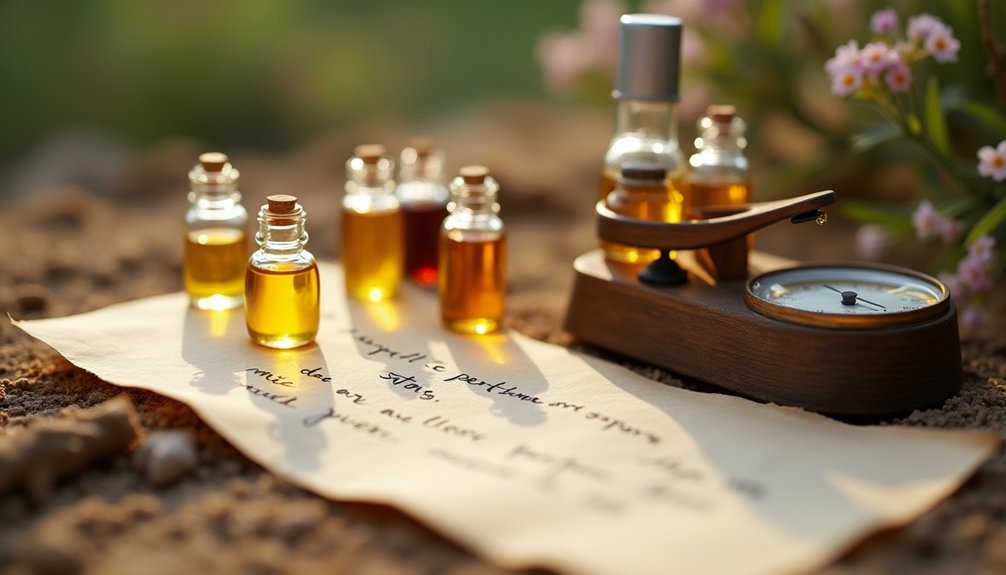
When creating your own perfumes, understanding essential oil concentration becomes your foundation for both safety and scent success.
You'll need to maintain a proper dilution rate of 1 part essential oils to 10 parts carrier oil or alcohol to guarantee a safe and pleasant fragrance experience.
While some perfumes contain essential oils at concentrations between 10% and 25%, you'll want to stick to the lower end of this range for everyday use.
Each essential oil carries its own sensitivity potential – for instance, cinnamon bark oil shouldn't exceed 0.07% in your blend, while frankincense offers more flexibility.
You'll need to be especially careful with citrus oils, as higher concentrations can cause photosensitivity and skin darkening.
The Science Behind Safe Dilution Ratios
Although creating perfumes might seem like a purely artistic endeavor, the science of dilution ratios forms the backbone of safe formulation.
You'll need to carefully balance fragrance oils with carrier oil to create a safe, wearable scent. The general rule suggests using 10-20% fragrance concentration to prevent skin reactions.
When working with essential oils, you'll want to follow these critical guidelines:
- Start with a 1:10 ratio of fragrance to carrier oil for most perfume formulations
- Reduce concentrations for highly sensitizing oils, especially with citrus-based ingredients that can cause photosensitivity
- Research specific safe limits for each oil type, noting that some oils like cinnamon bark require extremely low concentrations (0.07%)
Your attention to proper dilution guarantees both safety and a peak scent experience while preventing potential adverse skin reactions.
Common Carrier Oils and Their Properties
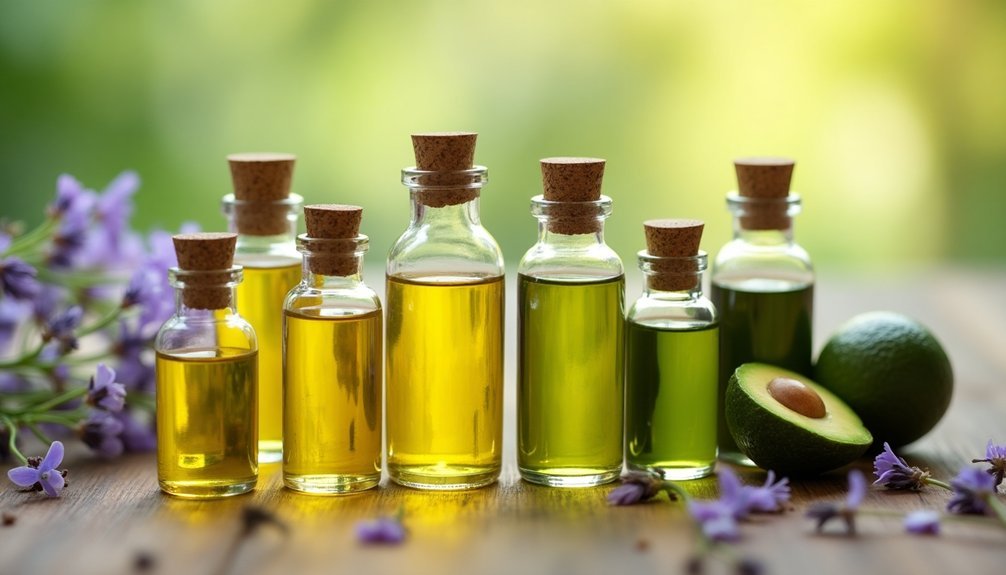
When making your perfume, you'll find jojoba oil stands out as a top carrier choice due to its remarkable similarity to your skin's natural oils and excellent absorption rate.
Popular unscented bases like sweet almond oil and fractionated coconut oil offer varying levels of skin compatibility, with sweet almond providing vitamin-rich nourishment and coconut oil delivering quick absorption.
Your skin type will ultimately determine which carrier oil works best, as absorption rates vary considerably among these options, with jojoba typically offering the most balanced absorption for most skin types.
Properties Of Jojoba Oil
Jojoba oil stands as a remarkable carrier oil for perfume making, thanks to its skin-friendly properties and long-lasting stability.
You'll find it's particularly effective because it mimics your skin's natural oils, allowing fragrance oils to blend seamlessly while providing excellent absorption.
What makes jojoba oil exceptional for your perfume formulations:
- It's non-comedogenic, making it safe for all skin types without clogging pores.
- You'll get up to 2 years of shelf life, ensuring your perfumes stay fresh longer.
- Its lightweight texture helps distribute fragrance oils evenly while nourishing your skin with vitamins E, B, and essential fatty acids.
When you're crafting perfumes, you'll appreciate how jojoba oil's natural properties enhance both the staying power and skin-friendliness of your fragrances, making it an ideal choice for your formulations.
Popular Unscented Base Options
The world of carrier oils offers several exceptional unscented base options for your perfume creations.
You'll find that jojoba oil mimics your skin's natural oils perfectly, making it an ideal carrier oil for sensitive skin types.
Sweet almond oil delivers essential vitamins A and E while remaining gentle enough for most users.
If you're looking for quick absorption, fractionated coconut oil provides a lightweight base that won't leave you feeling greasy.
For those concerned about pore-clogging, grapeseed oil's high linoleic acid content and light texture make it an excellent choice.
When working with fragrance oils, consider apricot kernel oil – it nourishes mature or dry skin while adding a subtle, complementary scent to your perfume blends.
Each of these carriers brings unique benefits to your perfume formulations.
Skin Absorption Rates
Understanding absorption rates plays an essential role in selecting the perfect carrier oil for your perfume. Different carrier oils penetrate your skin at varying speeds, which affects how your fragrance performs and feels.
When considering skin absorption rates, you'll find that lighter oils like jojoba and fractionated coconut oil sink in quickly, while heavier options like avocado oil take longer to absorb.
Here's what you need to know about common carrier oils:
- Jojoba oil mimics your skin's natural sebum, offering rapid absorption with minimal residue.
- Sweet almond oil provides balanced absorption with nourishing properties.
- Grapeseed oil delivers quick penetration and a non-greasy finish.
You'll want to match your carrier oil's absorption rate to your perfume's intended use, considering factors like lasting power and skin feel.
Essential Oil Categories and Their Safe Limits
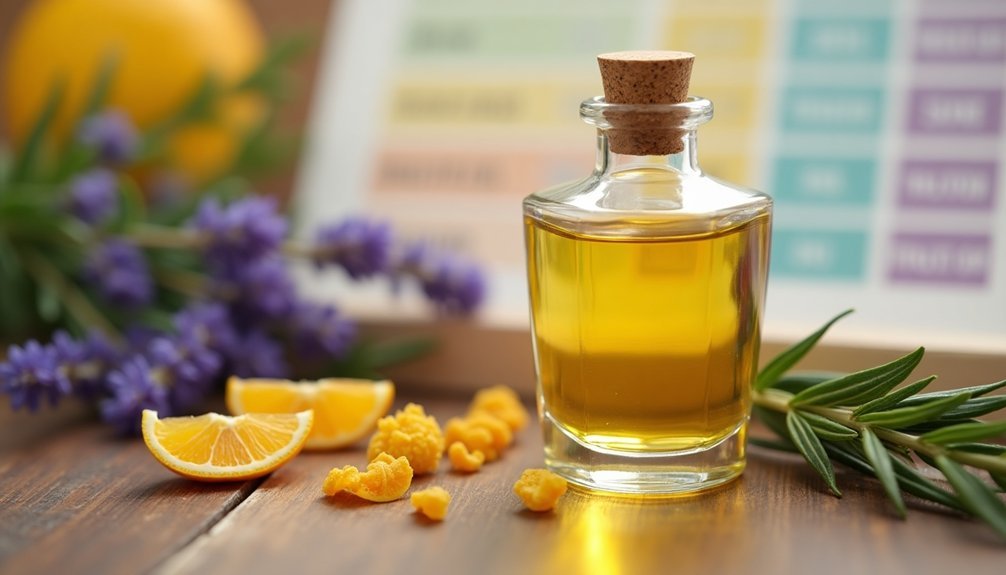
When crafting perfumes, you'll need to follow specific safety limits for different essential oil categories, with base notes like Vetiver restricted to 0.07% concentration for ideal safety.
You must be particularly careful with sensitizing oils such as cinnamon bark, which shouldn't exceed 0.07% in your formulation to prevent adverse skin reactions.
If you're working with citrus oils, keep their concentrations conservative and warn users about potential skin darkening with sun exposure, following IFRA's established guidelines for each oil type.
Base Note Safety Limits
Safe handling of base note essential oils demands careful attention to established concentration limits, as these long-lasting fragrance components can pose significant skin sensitization risks.
When you're working with base notes in your perfume formulations, you'll need to follow IFRA's strict guidelines to protect your skin.
Here's what you must consider when working with base note fragrance oils:
- Cinnamon bark oil, a popular base note, shouldn't exceed 0.07% concentration due to its high sensitization potential.
- You'll need to verify each oil's specific limit, as some base notes like frankincense don't have established restrictions.
- For longer-lasting base notes containing citrus oils, you must account for potential photosensitivity issues and adjust concentrations accordingly.
Always reference current IFRA guidelines before finalizing your perfume formula to guarantee safe, compliant concentrations.
Citrus Oil Concentration Rules
Since citrus oils carry a heightened risk of photosensitivity and skin reactions, you'll need to strictly monitor their concentrations in your perfume formulations.
When working with fragrance oils containing citrus components, you should maintain bergamot at no more than 0.4% and lemon oil below 5% of your total blend.
While citrus oils can create vibrant, uplifting scents, their sensitizing potential requires careful consideration.
You'll want to stay well below the maximum 10% perfume concentration guideline – even lower percentages are often safer for skin applications.
Remember that each citrus oil has its own specific safety threshold, similar to how cinnamon bark oil must remain below 0.07%.
Before incorporating any citrus oils into your perfume, research their individual safe limits to guarantee your final product won't cause adverse reactions.
Sensitizing Oils Guidelines
Understanding the varying sensitivity levels of different oils requires careful attention to their maximum concentration limits.
When working with sensitizing oils, you'll need to follow strict guidelines to create safe fragrance oils that won't irritate your skin.
Here are the key concentration limits you must follow:
- Highly sensitizing oils like cinnamon bark should never exceed 0.07% in your final formulation.
- Citrus oils should stay under 5% to prevent photosensitivity reactions.
- Clove bud oil must remain at or below 0.5% in cosmetic blends.
While some oils like frankincense offer more flexibility with no established maximum limit, it's essential to maintain proper dilution ratios between 10% and 25% for daily use.
Always research each oil's specific limitations before incorporating them into your perfume formulations to guarantee safety and comfort.
Measuring and Blending Techniques for Perfect Ratios
Creating precise fragrance blends requires accurate measurements and systematic techniques to achieve perfect ratios.
You'll need to start by measuring your ingredients with a precise scale, recording each component's weight to guarantee you can replicate successful formulations.
When blending, follow structured methods like the Jean Carles technique, which helps you layer your top, middle, and base notes effectively.
You'll want to maintain a 10-20% dilution rate for skin-safe applications, while perfume formulations typically contain 15-25% fragrance oil for ideal strength.
Use tools like beakers and pipettes to enhance your measuring accuracy.
This attention to detail lets you experiment creatively while staying within safe limits.
Avoiding Skin Sensitization Through Proper Dilution
To protect your skin from potential irritation and adverse reactions, proper dilution of fragrance oils stands as the cornerstone of safe perfume creation.
When making DIY perfume, you'll need to follow the 1:10 ratio rule – one part fragrance oil to ten parts carrier oil or alcohol. This guarantees your blend remains safe for skin application while maintaining its aromatic properties.
For ideal safety in your DIY perfume journey, follow these essential guidelines:
- Choose non-comedogenic carriers like jojoba or sweet almond oil
- Keep sensitizing oils below 0.07% concentration
- Use citrus oils sparingly to prevent photosensitivity
Don't skip the patch test before applying your creation regularly. Apply a small amount to your inner arm and wait 24 hours to check for any adverse reactions.
Top, Middle, and Base Note Balance Guidelines
Building a well-balanced perfume requires careful attention to the three essential note layers: top, middle, and base. When making perfume, you'll want to follow the 30-50-20 ratio: 30% top notes, 50% middle notes, and 20% base notes. This classic distribution guarantees your fragrance oils blend harmoniously and evolve beautifully on your skin.
| Note Layer | Characteristics |
|---|---|
| Top | Light, volatile, citrus, herbs |
| Middle | Floral, fruity, core scent |
| Base | Rich, woody, long-lasting |
| Ratio | 30-50-20 split |
| Duration | Short to long-lasting |
While you can experiment with different combinations, maintaining this balance prevents any single note from dominating your blend. Remember that top notes create first impressions, middle notes form the heart, and base notes provide the lasting foundation of your perfume.
Creating Long-Lasting Scents With Correct Proportions
To create a long-lasting perfume, you'll want to start with a strong base note foundation comprising 20-30% of your total fragrance composition.
You'll achieve the best results by combining your chosen fragrance oils with carrier oils at a 1:10 ratio, ensuring both safety and proper scent diffusion.
Let your mixture age for at least 48 hours, though aging for up to a month will give you the most harmonious and enduring scent possible.
Layering Base Note Oils
When crafting long-lasting perfumes, understanding base note oils becomes vital for achieving the perfect foundation.
You'll want to guarantee these deep, rich scents make up 30-50% of your total composition when making fragrance blends that last.
To create a well-balanced perfume, consider these significant steps:
- Balance heavier and lighter base notes according to their individual evaporation rates.
- Follow the 1:2:3 ratio rule – one part base notes, two parts heart notes, and three parts top notes.
- Allow your blend to age for at least 48 hours to enhance integration.
Oil-to-Carrier Ratio Basics
Creating safe and effective perfumes relies on three fundamental oil-to-carrier ratios that you'll need to master.
The first is the standard 1:10 ratio, where you'll combine one part fragrance oils with ten parts carrier oil or alcohol.
Next, consider the 10-20% dilution rate for skincare-safe perfumes that you'll wear daily.
Finally, when working with a 5ml bottle, aim for a 20% concentration by mixing 20 drops of fragrance oils with 80 drops of carrier oil.
Your oil-to-carrier ratio isn't just about safety – it's essential for creating a perfume that develops rich, complex notes over time.
After blending your oils in the correct proportions, you'll want to age the mixture for at least 48 hours, though a month is ideal for achieving the best scent depth.
Aging For Scent Depth
The art of perfume aging transforms a basic blend into a sophisticated fragrance with remarkable depth. When you properly blend fragrance oils, you'll need to give them time to develop their full potential. This essential aging process can take anywhere from 48 hours to a month, allowing the scent notes to meld seamlessly.
To achieve the best results during aging, follow these essential steps:
- Maintain precise measurements of 1:10 ratio between fragrance oils and carrier base.
- Test the evolving scent on your skin regularly to assess its development.
- Allow sufficient aging time for the top, middle, and base notes to harmonize.
You'll notice your perfume's complexity enhance over time as the aging process works its magic, creating a well-balanced and long-lasting signature scent that's uniquely yours.
Storage and Shelf Life Considerations
To maximize the lifespan of your homemade perfume, proper storage techniques are crucial.
You'll want to keep your creation in a dark, cool place away from heat and direct sunlight, as these elements can quickly break down your fragrance. For ideal storage, use dark glass bottles that protect against light exposure, extending your perfume's shelf life.
Don't forget to label your bottles with the creation date and ingredients list – this helps you track the age of your perfume and guarantees safe usage.
While most DIY perfumes can last between 6 months to 2 years, their longevity depends heavily on how well you store them. As your perfume ages and develops complexity over its initial curing period, keep monitoring it for any unexpected changes in appearance or scent.
Testing and Documentation Methods
Recording accurate measurements and testing results forms the foundation of safe perfume creation.
You'll need a precise scale to weigh your fragrance and carrier oils in grams, maintaining detailed documentation of each ingredient's proportions. Testing your formulations systematically guarantees both safety and repeatability.
Keep your fragrance-making journey organized with these essential documentation steps:
- Record exact weights and dilution ratios, typically staying within 10-20% for skin-safe applications.
- Note the creative inspiration and emotional elements behind each blend.
- Document patch testing outcomes to verify skin compatibility.
Your testing process should include regular review of your notes, helping you refine your technique and maintain consistent safety standards.
This methodical approach to documentation guarantees you can recreate successful blends while avoiding potentially harmful combinations.
Regulatory Standards and Safety Compliance
Since safety remains paramount in perfumery, understanding and following regulatory standards is essential for creating compliant fragrances.
Creating safe, compliant fragrances requires a thorough understanding of regulatory standards – the foundation of responsible perfumery.
The International Fragrance Association (IFRA) sets strict guidelines that you'll need to follow for different product categories, with specific attention to fragrance oils concentration limits.
You'll find that each product type has its own safety threshold – lotions can only contain 0.07% fragrance, while other products may allow different percentages.
It's vital that you maintain proper dilution ratios between 10-20% for skin contact products to prevent sensitization and allergic reactions.
To stay compliant, you'll need to regularly check the IFRA database for updates on safety guidelines.
Remember that certain essential oils have legal restrictions, so monitoring and documenting your usage amounts isn't just good practice – it's a regulatory requirement.
Frequently Asked Questions
What Is the 30/50/20 Rule for Perfume?
You'll create balanced perfumes by following the 30/50/20 rule: use 30% base notes for longevity, 50% heart notes for main character, and 20% top notes for initial impression in your fragrance blend.
What Percentage of Oil Is Best for Perfume?
You'll want to start with a 10% fragrance oil concentration for your perfume. If you're experienced, you can go up to 15-25%, but it's safer to begin with less to avoid potential skin reactions.
What Is the 30/50/20 Rule for Essential Oils?
You'll want to blend your essential oils using 30% base notes for lasting depth, 50% heart notes for main character, and 20% top notes for initial impression. This ratio creates well-balanced, harmonious fragrances.
What Is the Ratio of Essential Oils to Perfume?
You'll want to use a 10-20% ratio of essential oils to carrier oil in your perfume. That means for every 10 drops of carrier oil, you'd add 1-2 drops of essential oil.
In Summary
Proper oil ratios aren't just about creating beautiful fragrances – they're essential for your safety and the longevity of your perfumes. You'll need to maintain careful measurements, keep detailed records, and follow industry guidelines to create safe, effective blends. Whether you're a beginner or experienced perfumer, understanding and respecting these ratios will guarantee your creations remain both safe and appealing.
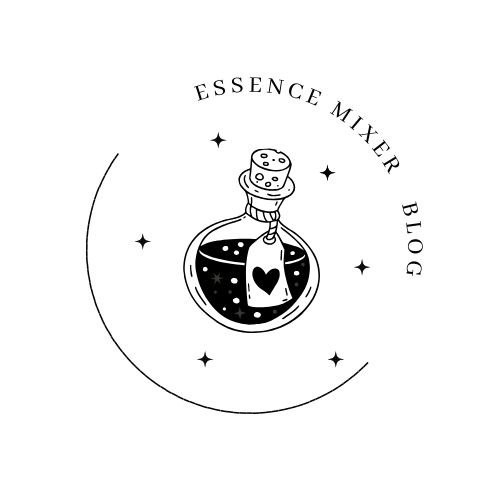
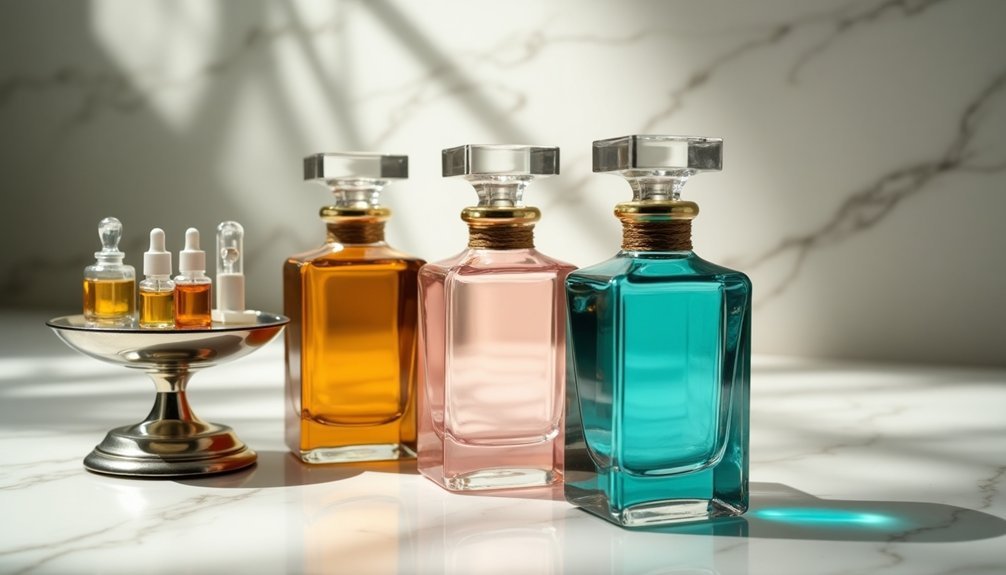



Leave a Reply